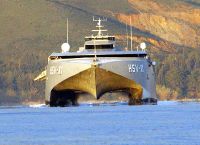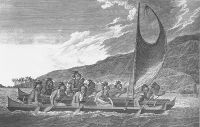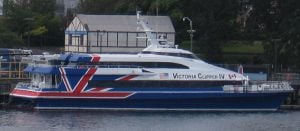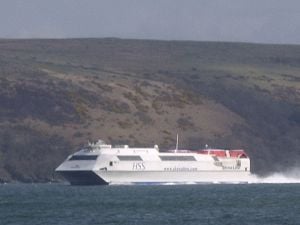Catamaran

A catamaran (from Tamil kattu "to tie" and maram "wood, tree") is a type of boat or ship consisting of two hulls joined by a frame. Catamarans can be sail- or engine-powered. The catamaran was the invention of the paravas, a fishing community in the southern coast of Tamil Nadu, India. Catamarans were used by the ancient Tamil Chola dynasty as early as the 5th century AD for moving their fleets to conquer such Southeast Asian regions as Burma, Indonesia and Malaysia.
Catamarans are a relatively recent design of boat for both leisure and sport sailing, although they have been used for millennia in Oceania, where Polynesian catamarans and outrigger canoes allowed seafaring Polynesians to settle the world's most far-flung islands. Catamarans have been met by a degree of skepticism from some sailors accustomed to more "traditional" designs.
History
The English adventurer and buccaneer William Dampier, traveling around the world in the 1690s in search of business opportunities, once found himself on the southeastern coast of India, in Tamil Nadu on the Bay of Bengal. He was the first to write in English about a kind of vessel he observed there. It was little more than a raft made of logs. "On the coast of Coromandel," he wrote in 1697, "they call them Catamarans. These are but one Log, or two, sometimes of a sort of light Wood ... so small, that they carry but one Man, whose legs and breech are always in the Water."
While the name came from Tamil, the modern catamaran came from the South Pacific. English visitors applied the Tamil name catamaran to the swift, stable sail and paddle boats made out of two widely separated logs and used by Polynesian natives to get from one island to another.
The design remained relatively unknown in the West for almost another 200 years, when an American, Nathanael Herreshoff, began to build catamaran boats to his own design. The speed and stability of these catamarans soon made them popular pleasure craft, with their popularity really taking off in Europe, and was followed soon thereafter in America. Currently, most individually owned catamarans are built in France, South Africa, and Australia.
In the twentieth century, the catamaran inspired an even more popular sailboat. In 1947, surfing legend, Woodbridge "Woody" Brown and Alfred Kumalae designed and built the first modern ocean-going catamaran, Manu Kai, in Hawaii. Their young assistant was Rudy Choy, who later founded the design firm Choy/Seaman/Kumalae (C/S/K, 1957) and became a fountainhead for the catamaran movement. The Prout Brothers, Roland and Francis, experimented with catamarans in 1949 and converted their 1935 boat factory in Canvey, Essex (England) to catamaran production in 1954. Their Shearwater catamarans won races easily against the single hulled yachts.
Later, in California, a maker of surfboards, Hobie Alter produced (1967) the 250-pound Hobie Cat 14, and two years later the larger and even more successful Hobie 16. That boat remains in production, with more than 100,000 made in the past three decades.
Presently the catamaran market is the fastest growing segment of the entire boating industry. Other important builders of catamarans are Austal and Incat both of Australia, best known for building large catamarans both as civilian ferries and as naval vessels.
Catamaran sailing
Although the principles of sailing are the same for both catamarans and monohulls, there are some "peculiarities"to sailing catamarans. For example:
- Catamarans can be harder to tack (turn through the wind). All sailboats must resist lateral movement in order to sail in directions other than downwind. A catamaran does this by the design of the hull giving comparatively little resistance to forward motion and much resistance to lateral motion. This lateral resistance is all along the hull, as opposed to most sailboats having a central keel projecting deep into the water from the center of the boat. While the catamaran’s method allows it to sail into shallower waters, it has the negative effect of placing lateral resistance at the bow and stern, far from turning axis of the boat, where the intended lateral resistance becomes a turning resistance due to the distance the bow and stern have to move in order to complete a turn. Regular sailboats with their deep lateral resistance occurring near the turning axis of the boat, there is much less turning resistance. Also, because catamarans are lighter in proportion to their sail size, they have less momentum to carry them through the turn when they are head to wind. Correct use of the jib sail is often essential in successfully completing a tack without ending up stuck in irons (pointing dead into the wind and sailing backwards, see: No Go Zone).
- They have a higher average speed.
- Catamarans are less likely to capsize in the classic 'beam-wise' manner but often have a tendency to 'pole-axe' (or 'pitchpole') instead - where the leeward (downwind) bow sinks into the water and the boat 'trips' over forward, leading to a capsize.
Teaching for new sailors is usually carried out in monohulls as they are thought easier to learn to sail, a mixture of all the differences mentioned probably contributes to this.
Catamarans, and multihulls in general, are normally faster than single-hull boats for four reasons:
- each hull of a catamaran is (typically) thinner in cross section than those of monohulls;
- catamarans are lighter due to the fact there is no keel counterweight.
- catamarans have a wider beam (the distance from one side of the boat to the other), which makes them more stable and therefore able to carry more sail area per unit of length than an equivalent monohull.
- the greater stability means that the sail is more likely to stay upright in a gust, drawing more power than a monohull's sail which is more likely to heel (lean) over.
A catamaran is most likely to achieve its maximum speed when its forward motion is not unduly disturbed by wave action. This is achieved in waters where the wavelength of the waves is somewhat greater than the waterline length of the hulls, or it is achieved by the design piercing the waves. In either case pitching (rocking horse-like motion) is reduced. This has led to it being said that catamarans are especially favorable in coastal waters, where the often sheltered waters permit the boat to reach and maintain its maximum speed.
Catamarans make good cruising and long distance boats: The Race (around the world, in 2001) was won by the giant catamaran Club Med skippered by Grant Dalton. It went round the earth in 62 days at an average speed of eighteen knots.
Catamaran designs
Popular small racing catamaran sailboats include:
- The Hobie cats (especially the 16-foot long Hobie 16, as well as many other designs including 14, 17, 18, and 20 ft models.)
- International A-Class (open design; length 5.49 m (18 ft), beam 2.3 m (7 ft 6.5 in), weight 75 kg, sail 13.94 m² (150 ft²))
- Formula classes (F16, F18, F20)
- Sprint 15
- Topcat
- Tornado, Olympic class racing catamaran.
Small sailing catamarans that are mass-produced, trailerable, and can be beached on sandy shores are commonly called "beach cats".
Catamarans for passenger transport
An increasing trend is the deployment of a catamaran as a high speed ferry.
The use of catamaran for high speed passenger transport was pioneered by Westermoen Hydrofoil in Mandal, Norway, who launched the Westamaran design in 1973. The Westamarans, and later design, some of them consisting of a catamaran hull resting on an air cushion between the hulls, became dominant for all high speed connections along the Norwegian coast. They could achieve speeds comparable to the hydrofoils that it replaced, and was much more tolerant to foul water and wave conditions.
There is a List of catamaran ferry routes documenting the growing number of routes.
Powered catamarans
A recent development in catamaran design has been the introduction of the power catamaran. The 'power' version incorporates the best features of a motor yacht and combines it with the traditional sailing characteristics of a multihull.
Usually, the power catamaran is devoid of any sailing apparatus as demonstrated by one of the top-selling models in the United States, the Lagoon Power 43. This vessel has now been introduced to a number of charter fleets in the Caribbean and the Mediterranean and is becoming an increasingly common sight.
Smaller powered catamarans are becoming quite common in the United States with several manufacturers producing quality boats. A small "cat" will almost certainly have 2 engines while a similar sized mono-hull would only one engine. All mid-size and larger cats will have 2 engines.
Mega catamarans
One of the biggest developments over the last decade in the yachting arena has been the rise of the super catamaran - a multihull over 60 feet in length which come in semi-custom and custom designs.
Various international manufacturers are leading the way in this area including Blubay, Yapluka, Sunreef, Lagoon and Privilege. A catamaran of 150 feet in length is under construction at Derektor shipyards in Bridgeport, Connecticut.
The emergence of the super or mega catamaran is a relatively new event which is akin to the rise of the mega or super yacht which was used to describe the huge growth in luxury, large motor yachts in the French Riviera and Floridian Coast.
One of the reasons for increased mega catamaran construction was The Race, a circumnavigation challenge which departed from Barcelona, Spain, on New Year's Eve, 2000. Due to the prize money and prestige associated with this event, four new catamarans (and two highly modified ones) over 100' in length were built to compete. The largest, "PlayStation", owned by Steve Fossett, was 125' long and had a mast which was 147' above the water. Virtually all of the new mega cats were built of pre-preg carbon fiber for strength and the lowest possible weight. Top speeds of these boats can approach 50 knots.
See also
Template:CommonsCat
- Hokule'a
- International Catamaran Challenge Trophy
- International C-Class Catamaran Championship
- Multihull
- SWATH, another twin hull design
- Trimaran
External links
All links Retrieved December 8, 2007.
- Mysterious Spider Boat Appears Out of the Fog - Antrim Associates is testing a new concept of ocean-going catamaran.
- Super Yacht Catamarans Here is the limited list of large superyacht catamarans in the world
- Woods Designs Designs of cruising catamarans for home build
- Catamaran Sailing at TheBeachcats.com Site devoted to all types of small catamarans known as beachcats.
- Dart 18 Catamaran UK Class Site for Dart 18 sailors in England.
- Dart 18 Catamaran World Championships 2008 Site for all people interested in the Dart 18 Worlds.
Credits
New World Encyclopedia writers and editors rewrote and completed the Wikipedia article in accordance with New World Encyclopedia standards. This article abides by terms of the Creative Commons CC-by-sa 3.0 License (CC-by-sa), which may be used and disseminated with proper attribution. Credit is due under the terms of this license that can reference both the New World Encyclopedia contributors and the selfless volunteer contributors of the Wikimedia Foundation. To cite this article click here for a list of acceptable citing formats.The history of earlier contributions by wikipedians is accessible to researchers here:
The history of this article since it was imported to New World Encyclopedia:
Note: Some restrictions may apply to use of individual images which are separately licensed.




